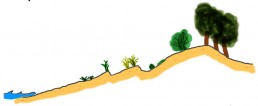Plant biodiversity and adaptation to the environment on coastal dunes
Beaches and sand dunes impose extreme conditions on plants that are at the limit of their survival: the constant wind carries salt droplets that encrust them and sand that continually grinds and submerges them, the substrate does not retain moisture and can reach temperatures of 60 °C. Only psammophytes, or sand plants, can survive in these conditions, thanks to special adaptations.
Only psammophytes, or sand plants, can survive in these conditions, thanks to special adaptations.
To protect themselves from the wind, many species are small or grow on the ground, such as fumana (Fumana procumbens). To find and store what little water is available, the maritime vilucchio (Convolvulus soldanella) and the ravastile (Cakile maritima) have deep roots and fleshy leaves where they store water, like desert cacti. To protect itself from the high temperatures, marine alfalfa (Medicago marina) covers itself with a felt of hairs. Species such as sea holly (Eryngium maritimum), juniper (Juniperus communis) and holm oak (Quercus ilex) have stiff, leathery leaves covered with waxes to limit water loss.
Other plants have adapted to being submerged in sand: the prickly sparto (Ammophila arenaria) develops underground stems (rhizomes) whose growth is stimulated by submergence. Thanks to its rhizomes, this species traps grains of sand and allows dunes to form: it is the true "dune engineer".
It is the true "dune engineer";
Beaches and dunes generate and evolve thanks to the balance between the sea currents, which deposit the sand on the beach, the sun, which dries the sand, the wind, which carries it inland, and the plants, which trap it.
The plants that grow on the dune, as well as actively contributing to its construction, as the dune grows, form different communities arranged in bands (zones) parallel to the coastline, along the strong environmental gradients, to form the so-called coastal zoning.
The community closest to the sea is called Cakileto, named after the guide species Cakile maritima. Although small, the plants of the Cakileto dampen the action of the wind and allow the formation of the first accumulations of sand, the 'embryonic dunes'. It is here that the first perennial plants, such as Elymus farctus, grow, triggering the process of dune formation. Behind the Elymus farctus, the "mobile dunes" develop, colonised by Ammophila arenaria, a species that is very resistant to wind and silting up, whose tufts favour the accumulation of sand and react to silting up by growing in height, thus allowing the dune to grow. Behind the Ammofileto there is a protected zone, the "grey dunes".
The protection from the wind and saltiness allows the presence of more species and the formation of a prairie with flowering species, mosses and lichens, the Tortulo-Scabioseto.
The vegetation of the sandy shores reaches its most complex form in the 'fixed dunes'. The more sheltered conditions allow the development of shrub communities, often dominated by the common juniper (Juniperus communis). The Juniper wood consolidates the dune and creates the conditions for the development of the coastal wood, the Lecceta, dominated by Quercus ilex. The coastal woodland has become rare and has often been replaced by reforestation with Mediterranean pines (Pinus pinea, P. pinaster).



